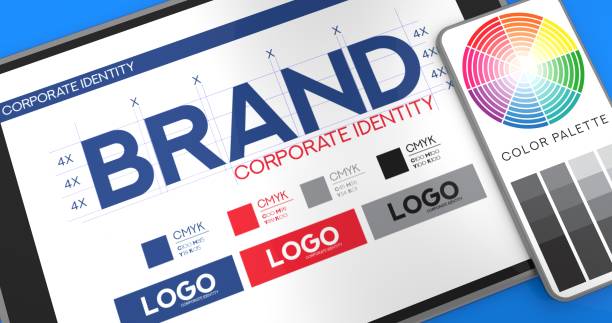Have you ever wondered why certain brands stick in your mind, even after a quick glance? Or why some logos instantly evoke a sense of trust or excitement? The answer often lies in a powerful but sometimes overlooked aspect of color in visual branding. In a crowded market, where countless brands compete for attention, the color palette you choose can be the first impression that shapes how your brand is perceived. Understanding and utilizing the psychology of color in your branding strategy isn’t just a design choice; it’s a competitive advantage.
In this post, we’ll explore how color impacts brand recognition, influences customer emotions, and shapes overall brand perception. Whether you’re a small business owner or a marketer looking to elevate your brand’s visual impact, this guide will provide practical insights to help you make color work for your brand.
The Role of Color in Branding: More Than Meets the Eye – Color in Visual Branding
Color isn’t just about aesthetics—it’s a language that communicates messages and feelings, often without words. In fact, studies show that color increases brand recognition by up to 80%. Additionally, this powerful element of design helps brands instantly connect with their audience and convey key brand values.
For instance, think about some of the world’s most iconic brands:
- Coca-Cola and its bold red: evoking excitement, energy, and passion.
- Apple and its sleek gray tones: symbolizing sophistication, quality, and modernity.
These brands have carefully chosen colors that resonate with their target audience and convey their core identity. So, colors offer a shortcut to your brand’s personality, instantly sparking emotions that influence how potential customers feel about your products or services.
The Psychology of Color: Understanding Emotional Impact
Different colors evoke different emotions, and savvy brands use this psychological impact to their advantage. So, here’s a quick breakdown of common colors in branding and the feelings they often evoke:
- Red: Passion, energy, and urgency. Brands like Target and YouTube use red to grab attention and create a sense of excitement.
- Blue: Trust, reliability, and calm. Popular among tech and finance brands like Facebook and PayPal, blue often instills a sense of stability.
- Green: Health, growth, and relaxation. Green is a common choice for brands focusing on nature, wellness, or eco-friendliness, such as Whole Foods and Starbucks.
- Yellow: Optimism, warmth, and happiness. Brands like McDonald’s and Ikea leverage yellow to create a welcoming and energetic atmosphere.
By understanding the psychology of color, brands can strategically select hues that align with their values and resonate with their audience.
Building Brand Recognition Through Color Consistency – Color in Visual Branding
Once you choose your brand colors, consistency is key. Additionally, consistently using the same colors across all branding elements—such as your logo, website, packaging, and social media—reinforces your brand identity and makes it easier for customers to recognize and remember you.
Think of how easy it is to spot an Amazon package or a Tiffany’s box just from the color alone. Furthermore, these brands have mastered color consistency, using it to their advantage to create memorable, instant recognition.
Practical Tip: Develop a Brand Color Guide
Creating a brand color guide is an excellent way to ensure color consistency across all platforms. Include exact color codes, such as HEX, RGB, or CMYK values, and share these codes with all design teams to keep your branding aligned.
Cultural Sensitivity in Color Choices
Color perception varies across cultures, and what works in one market might not resonate in another. So, if you’re planning on reaching a global audience, it’s important to consider cultural associations with colors. For example:
- In Western cultures, white often symbolizes purity and simplicity, but in some Eastern cultures, it’s associated with mourning.
- Red is seen as lucky and prosperous in Chinese culture, while in other contexts, it may represent danger or urgency.
Being mindful of cultural color connotations can help you avoid unintended miscommunications and build trust with diverse audiences.

Applying Color in Various Branding Elements – Color in Visual Branding
Incorporating your brand colors thoughtfully across different elements can strengthen your visual identity. So, here’s how color impacts various branding materials:
a) Logos and Icons
Your logo is often the first interaction people have with your brand. Additionally, choosing colors that represent your brand’s values in your logo can create a lasting impression.
b) Website and Digital Assets
From your website background to call-to-action (CTA) buttons, colors can guide users’ emotions and behaviors. For example, using contrasting colors for CTA buttons makes them stand out, encouraging clicks and conversions.
c) Packaging and Product Design
Color can influence purchase decisions in physical products, especially when packaging stands out on crowded shelves. Also, a unique color scheme can make products instantly recognizable, driving customer loyalty and brand preference.
Testing and Evolving Your Color Strategy
Just as customer preferences evolve, so should your approach to color. It’s essential to regularly test your color choices to ensure they’re still resonating with your audience. Additionally, conducting A/B testing with different color schemes on landing pages or social media ads can provide insights into which colors perform best.
Practical Tip: Leverage Analytics
Use tools like Google Analytics, heat maps, and social media insights to understand how color impacts your audience’s engagement. So, this data can guide you in optimizing your color strategy for maximum impact.
Successful Case Studies of Color in Branding
Curious about how big brands leverage color to build strong identities and emotional connections? Examining real-world examples can reveal just how impactful color can be. So, let’s dive into a few standout brands that have mastered the art of color in their branding, using thoughtful hues to create recognition, inspire loyalty, and convey their core values.
Case Study 1: Coca-Cola’s Red
Coca-Cola’s choice of red wasn’t accidental. Red is associated with excitement and passion, aligning perfectly with Coca-Cola’s brand message of energy and enjoyment. The consistency of their iconic red branding across decades has made it one of the most recognizable brands worldwide.
Case Study 2: Spotify’s Green
Spotify’s unique green branding sets it apart in a sea of streaming services. Green symbolizes growth and renewal, subtly reflecting Spotify’s message of musical discovery and evolution.
By examining successful brands, you can gain inspiration and learn how to effectively incorporate color into your own visual branding.

Practical Tips for Choosing Your Brand Colors – Color in Visual Branding
If you’re considering a rebrand or launching a new product, here are a few practical steps for selecting effective brand colors:
- Identify Your Brand’s Core Values: Start by defining what your brand stands for—trust, innovation, fun, etc. This will guide you to colors that match these values.
- Analyze Your Competitors: Take note of the colors used by competitors in your industry. Aim to differentiate your brand with a unique color scheme while staying relevant to the market.
- Consider Color Harmony and Balance: Colors should work well together to create a harmonious look. Try experimenting with different color combinations to find one that represents your brand while looking aesthetically pleasing.
- Test Your Colors Across Platforms: Make sure your colors look good on different mediums, from digital screens to printed materials. This ensures your brand colors will be effective wherever they appear.
Future Trends in Color and Branding – Color in Visual Branding
As technology and consumer preferences shift, so do color trends. Brands today are moving toward unique, vibrant colors and gradients, especially in digital spaces. Keeping an eye on these trends can help your brand feel modern and relevant.
Incorporating trendy colors can refresh your brand image, but make sure it aligns with your core values. The trend towards natural tones, for example, is ideal for eco-friendly brands, while bold and bright colors may suit tech startups looking to stand out.

Final Thoughts: Making Color Work for Your Brand – Color in Visual Branding
Incorporating color strategically in your branding can create a powerful connection with your audience, helping you stand out and build lasting brand loyalty. With a clear understanding of color psychology, consistency, and audience preferences, your brand can make an unforgettable impact.
Are you ready to harness the power of color in your branding strategy? Whether it’s through a bold logo, eye-catching packaging, or a cohesive website, the colors you choose can be the key to unlocking your brand’s full potential. So, dive in, explore, and let color be the vibrant thread that ties your brand’s story together!









[…] a market-defining brand requires dedication, consistency, and a customer-centric […]